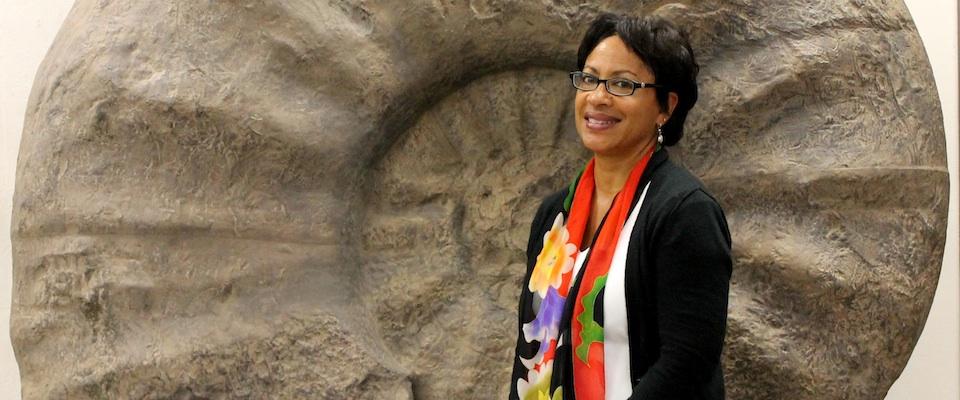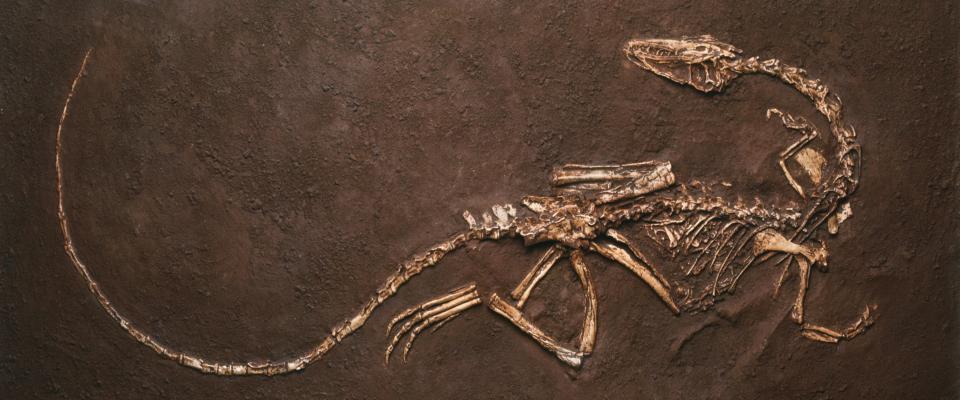Lisa White scrunches her nose and holds a magnifying glass up to one eye to inspect a peanut-sized vial seemingly full of large tan and ivory sand grains. But a closer look reveals rods, stars and corkscrews—the 50-million-year-old fossilized shells of forams, creatures that still populate the oceans today.
“You’re gonna see some cool stuff in here,” White, a 53-year-old paleontologist, promises the seventh-graders who surround her in a circle of khakis and green sweatshirts. These mostly Latino students from Urban Promise Academy in Oakland’s Fruitvale neighborhood are her target audience—minority kids she hopes to incite with her own passion for science.
As an African-American woman in one of the least diverse scientific fields, White, director of education and public programs at the University of California’s Museum of Paleontology, is accustomed to playing the part of role model. “There are very few female black geoscientists who study paleontology, so I get it,” she says with a chuckle. “I’m going to be asked reach out to youth a lot.”
So it’s fortunate that she retains a childlike fascination with all fossils, from tiny foram shells to towering dinosaur skeletons. Because the museum on the Cal campus is not open to the public, she brings its exhibits to them.
Today she has arranged bottles of fossils and trays of beach sand on tables at the back of the classroom. As the students explore and identify, White wades calmly into the organized chaos, her ammonite earrings—fossils of extinct mollusks with spiral shells—swinging back and forth and her perky haircut and chic, angular glasses framing an easy smile. She makes sure everyone finds the spindle-shaped foram that she calls, with a playful twang, “Schwag”—short for Schwagerina. and she challenges the students to imagine being the first person to gaze at rocks under a microscope.
Everyone loves to look at giant dinosaur fossils in museums, she tells the middle-schoolers, but microfossils are everywhere. Although the oldest fossils in White’s show-and-tell come from Pakistan, the sediments below this classroom could conceal billions of similar traces—remnants of plankton that fell to the bottom of the ocean and were compacted into rock over time.
“All of this material was underwater, you guys. But millions of years ago, the water retreated from the land. We’re just left with the Bay,” White explains. “The land uplifted. So that’s why we have rocks that contain marine fossils on land.”
These fossils, she tells them, serve as clues that allow scientists to reconstruct Earth’s history. “They do crazy stuff!” White says, her eyes widening. “There’s one group of forams that coil their shells clockwise in cold water, and counter-clockwise if it’s warm.”

White dedicated her early career to reconstructing ancient ocean patterns based on microfossils. But while a professor at San Francisco State University, she expanded her focus to science education and outreach for the city’s underserved minorities.
Her desire to promote earth science to minority youth may stem from the influence of her father, psychologist Joseph White. A founder of the Association of Black Psychologists, he worked to bring the perspectives of blacks and other minorities into the field of psychology and to widen educational opportunities. “She probably picked up the mentoring from me,” he says. “There have always been young people around me that I’ve been guiding.”
As a child growing up in San Francisco, Lisa White liked to dig around in the backyard—a habit no one in the family understood as an indication of her academic interest. Instead, captivated by the photographs of Ansel Adams, she enrolled as an art major at San Francisco State University, taking a geology class to fulfill a general education requirement.
Geologist David Mustart, later her colleague, was the first teacher to make science interesting and relevant for White. He brought in ash samples from Mount St. Helens, which had erupted just months earlier. For the first time, White saw how science could help people understand this incredible catastrophe. The course led to her first visit to a national park, Lassen, where she was enthralled by the unique volcanic landscapes. She first studied microfossils during an internship with the US Geological Survey in Menlo Park, where a colleague encouraged her to apply to graduate school at UC Santa Cruz.
She went on spend 22 years on the faculty of SF State. Besides teaching and mentoring her own students, she established a program to introduce minority youth to field geology. Reaching Out to Communities and Kids with Science in San Francisco, known as SF-ROCKS, began in 2001 with a grant from the National Science Foundation.

At the time, Dawn Rege was a teacher at Phillip & Sala Burton High School. When the school’s science department decided to implement a new earth science curriculum for its ninth-graders, there was just one problem—none of the teachers had a degree in that field.
The support of the SF-ROCKS program was invaluable, from teacher training to materials to field trips, Rege said. For a lesson on earthquakes, White showed her how to find a fault line right behind the school and guide her students to make observations that would tie into their lessons. “She really made sure that the opportunities were meaningful for our students,” Rege said.
Claire Bailey, an African-American who had long planned to become a medical doctor, credits the program with sparking her interest in geology. Now in her first year of doctoral research on plate tectonics at the University of Texas in El Paso, she recalled how SF-ROCKS transformed her understanding of earthquakes: “I had all these really crazy ideas, like that there was such a thing as earthquake weather.”
“I think many times when people visit museums, they very much see examples of the past, which are not very meaningful to what might matter in their lives today. So I am excited that museums want to do a better job.”
The experience also showed her that she could help people by becoming a geologist. “I liked how geology affects us so much as people,” she said. “A lot of those early things I did with SF-ROCKS had to do not only with geology, but with environmental justice.” White convinced Bailey to study geology.
“We’ve been told for years that geology is the least diverse of all the sciences,” White said. “Students of color may know scientists in their families or communities, and they’re usually physicians, or maybe they’re engineers. They’re doing work that can be perceived as more valuable, more connected to people’s well being. And geology isn’t always mentioned in that circle of fields.”
SF-ROCKS students have participated in long-term water quality monitoring studies in their communities and produced their own videos on environmental topics, such as the water supply for farms in California’s Central Valley and mercury contamination in fish in San Francisco Bay.
White also coordinates Minority Education Through Traveling and Learning in the Sciences, or METALS, a series of two-week summer field trips to national and state parks where undergraduates serve as mentors and conduct research alongside high school students.
Her major task at the moment is managing the creation of a new online resource, “Understanding Global Change”—coordinating a diverse team charged with building fresh educational content on the science of climate change and how it impacts life on Earth. In August, she’s leading a weeklong workshop for middle and high school science teachers, who will test-drive the web resource and hear from prominent climate scientists and ecologists.
“We need to beat back those misconceptions that creep in,” White said, “because you’ve got these well-funded institutes that make it their business to deny climate change. Through our online resources, we want to connect educators with authentic research and with the science supporting that global change is happening.”
The biological impacts of climate change will be a major focus. When asked for an example, White cites a story about ragweed. “It doesn’t sound very exciting,” she conceded. But this seemingly benign change could mean more miserable times for those with hay fever. “There’s lots of evidence to suggest that there’s just more of it, and pollen and allergies associated with ragweed will increase, because it’s the kind of plant that benefits from climate change and frost-free conditions, and can thrive in all kinds of environments.”
White’s flair for making science relevant is widely recognized. She recently served on an advisory board for the Smithsonian’s new fossil hall, slated to open in 2019.
“I think many times when people visit museums, they very much see examples of the past, which are not very meaningful to what might matter in their lives today,” she said. “So I am excited that museums want to do a better job of connecting the whole fossil record to evidence of evolution, to things constantly changing on Earth, and how we know what we know.”
Unlike the Smithsonian, the Berkeley museum is a far cry from what most people imagine a museum to be. In the basement of Berkeley’s Valley Life Sciences Building, it’s tucked away behind the tail of a two-story T. rex skeleton. White’s office is a fluorescently lit cavern lined with file cabinets. Behind a glass wall, more than 350,000 specimens—the largest paleontological collection of any university in the world—are stored on endless rows of collapsible bookshelves. The assemblage ranges from the imprints of salmon that swam in the ancient lakes of western Nevada to the teeth of a camel that roamed California during the last ice age.
“People think that research at Berkeley only serves certain audiences,” White said. “We’re trying to reach entire communities that may never be able to access the collections at the museum, but I think they can get excited about what those collections tell us about life in the past.”
She believes in the power of informal learning beyond the textbook—the kind that happens when students closely observe microfossils, or make connections between geological processes and the landscapes they see outdoors. “That’s what’s great about working in a museum that’s different from when I was a professor,” she said. “Now I have greater access to all these informal learning communities, which some research suggests are critical to students’ learning and development around science.”





















